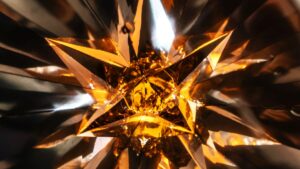
A team of researchers has made a significant breakthrough by creating a time crystal that exhibits both order and chaos, offering new insights into how matter can maintain temporal structure. The study, led by physicists Leo Joon Il Moon from the University of California, Berkeley, and Paul Schindler from the Max Planck Institute for the Physics of Complex Systems in Germany, reveals a form of temporal order that emerges from non-periodic yet structured drives.
The newly developed time rondeau crystal repeats in time, but in a manner that never fully aligns with previous cycles. According to the researchers, this can result in chaotic behavior over short timescales, while longer observation periods reveal an underlying order. “In this work, we reveal the existence of new types of temporal order, arising from non-periodic but structured drives,” the team states.
This research builds upon the concept of time crystals, first proposed by Frank Wilczek in 2012 and observed experimentally in 2016. Traditional crystals like diamond and quartz are characterized by their three-dimensional atomic lattices, where the arrangement of atoms repeats uniformly. In contrast, time crystals allow particles to oscillate through states that are not dictated by external forces, thus breaking conventional time flow.
Exploring the Structure of Time Rondeau Crystals
The researchers define a time rondeau crystal as one that embodies both periodicity and non-periodicity, similar to the musical form of a rondeau. They explain that this structure comprises a repeating theme of stroboscopic order that alternates with contrasting variations. This analogy draws on classical music, highlighting the complexity of the time crystal’s behavior.
To create their time crystal, the team utilized atomic-scale voids, known as nitrogen-vacancy centers, within a diamond. These vacancies are sites where an atom is missing, creating a unique lattice arrangement. By exciting the nitrogen-vacancy centers with lasers, the researchers hyperpolarized the nuclear spins of carbon-13 atoms in the diamond. A programmable arbitrary waveform generator then applied precisely timed sequences of pulses to drive the spins, which ranged from periodic to random.
During the experiments, the team monitored hundreds of drive cycles, noting that the time crystals could oscillate for over 4 seconds before stabilizing. Despite the apparent disorder within each cycle, the overall state of the time crystal repeated itself at the beginning of each cycle, demonstrating a remarkable level of organization.
Future Implications and Innovations
The researchers took their investigation further by encoding text—”Experimental observation of a time rondeau crystal. Temporal Disorder in Spatiotemporal Order”—directly into the timing of their laser pulses using the ASCII standard. While there are no immediate practical applications for this discovery, it opens exciting possibilities for future research in the field of temporal order.
“Our experiments open a promising new avenue to investigate temporal order,” the researchers conclude, emphasizing the stable coexistence of long-range temporal order and micromotion disorder at short timescales. This study has been documented in the scientific journal Nature Physics, contributing to the growing body of research on the fascinating properties of time crystals.
As the scientific community continues to explore these complex structures, the potential for new technologies and insights into the nature of time itself may be on the horizon.






